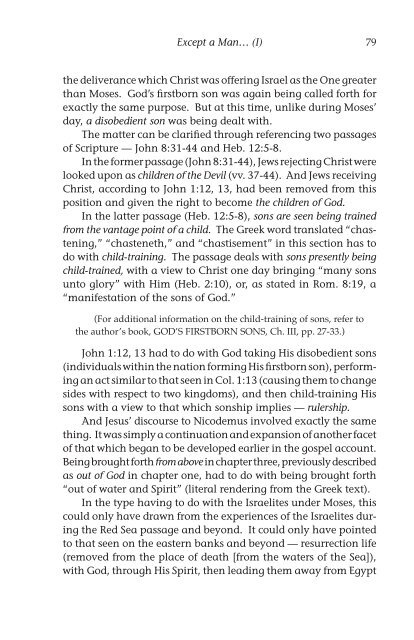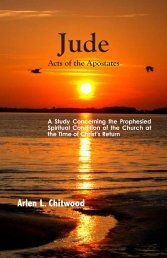Signs in John's Gospel - The Lamp Broadcast
Signs in John's Gospel - The Lamp Broadcast
Signs in John's Gospel - The Lamp Broadcast
Create successful ePaper yourself
Turn your PDF publications into a flip-book with our unique Google optimized e-Paper software.
Except a Man… (I) 79<br />
the deliverance which Christ was offer<strong>in</strong>g Israel as the One greater<br />
than Moses. God’s firstborn son was aga<strong>in</strong> be<strong>in</strong>g called forth for<br />
exactly the same purpose. But at this time, unlike dur<strong>in</strong>g Moses’<br />
day, a disobedient son was be<strong>in</strong>g dealt with.<br />
<strong>The</strong> matter can be clarified through referenc<strong>in</strong>g two passages<br />
of Scripture — John 8:31-44 and Heb. 12:5-8.<br />
In the former passage (John 8:31-44), Jews reject<strong>in</strong>g Christ were<br />
looked upon as children of the Devil (vv. 37-44). And Jews receiv<strong>in</strong>g<br />
Christ, accord<strong>in</strong>g to John 1:12, 13, had been removed from this<br />
position and given the right to become the children of God.<br />
In the latter passage (Heb. 12:5-8), sons are seen be<strong>in</strong>g tra<strong>in</strong>ed<br />
from the vantage po<strong>in</strong>t of a child. <strong>The</strong> Greek word translated “chasten<strong>in</strong>g,”<br />
“chasteneth,” and “chastisement” <strong>in</strong> this section has to<br />
do with child-tra<strong>in</strong><strong>in</strong>g. <strong>The</strong> passage deals with sons presently be<strong>in</strong>g<br />
child-tra<strong>in</strong>ed, with a view to Christ one day br<strong>in</strong>g<strong>in</strong>g “many sons<br />
unto glory” with Him (Heb. 2:10), or, as stated <strong>in</strong> Rom. 8:19, a<br />
“manifestation of the sons of God.”<br />
(For additional <strong>in</strong>formation on the child-tra<strong>in</strong><strong>in</strong>g of sons, refer to<br />
the author’s book, GOD’S FIRSTBORN SONS, Ch. III, pp. 27-33.)<br />
John 1:12, 13 had to do with God tak<strong>in</strong>g His disobedient sons<br />
(<strong>in</strong>dividuals with<strong>in</strong> the nation form<strong>in</strong>g His firstborn son), perform<strong>in</strong>g<br />
an act similar to that seen <strong>in</strong> Col. 1:13 (caus<strong>in</strong>g them to change<br />
sides with respect to two k<strong>in</strong>gdoms), and then child-tra<strong>in</strong><strong>in</strong>g His<br />
sons with a view to that which sonship implies — rulership.<br />
And Jesus’ discourse to Nicodemus <strong>in</strong>volved exactly the same<br />
th<strong>in</strong>g. It was simply a cont<strong>in</strong>uation and expansion of another facet<br />
of that which began to be developed earlier <strong>in</strong> the gospel account.<br />
Be<strong>in</strong>g brought forth from above <strong>in</strong> chapter three, previously described<br />
as out of God <strong>in</strong> chapter one, had to do with be<strong>in</strong>g brought forth<br />
“out of water and Spirit” (literal render<strong>in</strong>g from the Greek text).<br />
In the type hav<strong>in</strong>g to do with the Israelites under Moses, this<br />
could only have drawn from the experiences of the Israelites dur<strong>in</strong>g<br />
the Red Sea passage and beyond. It could only have po<strong>in</strong>ted<br />
to that seen on the eastern banks and beyond — resurrection life<br />
(removed from the place of death [from the waters of the Sea]),<br />
with God, through His Spirit, then lead<strong>in</strong>g them away from Egypt



